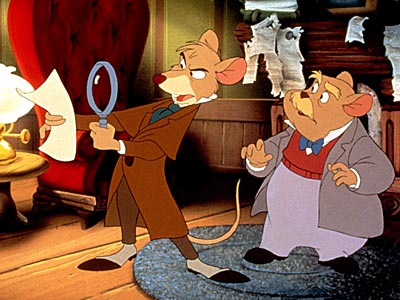The Great Mouse Detective: Rise and Fall of the Mouse
From the beginning the rodents were always there, tiny sidekicks running around in the periphery of Disney animated features, starting with Snow White and the Seven Dwarfs. Snow White’s woodland attendants included chipmunks, squirrels and rabbits as well as raccoons, bluebirds and other critters — everything but mice, it seems, though there is at least one mouse in the picture, an irritable little fellow in a mouse-hole in the Dwarfs’ house who objects to the sweeping squirrels using his hole as a dust-bin.

Bambi’s many woodland-creature cameos include a meadow mouse who takes shelter under a mushroom during a rainstorm. I don’t remember whether there are any mice in Pinocchio (where the key sidekick role goes to a cricket) or Fantasia — other than Mickey himself, of course, the Big Cheese of the Mouse House.
At any rate, Cinderella marks a notable turning point, with mice not only taking over the sidekick role as the heroine’s attendants, but threatening at times to take over the picture, too. They have names now, Jaq and Gus-Gus, and they become integral to the story and even to the climax to a concerning degree. It is here that the Disneyfication process begins to show signs of wear.
After Cinderella, they crop up here and there in other pictures, but their next big break is The Rescuers, where the mice actually become the stars of the picture. There is still a nominal human heroine, Penny, whom the mice are helping as their predecessors did in earlier pictures, but the movie is not about Penny, it’s about Bernard and Miss Bianca. The sidekicks have taken over.
Finally, the mice’s ultimate triumph: The Great Mouse Detective, in which the mouse heroes aid a damsel in distress who is herself a mouse, leaving humans out of the picture entirely. (There were no humans in Robin Hood either, but that movie was populated by lots of species, with mice in only a tiny role.)
At last the mice have taken over completely, and the only hint of human personality is the occasionally-glimpsed silhouette of Sherlock Holmes, playing his violin and murmuring in the background in the sampled voice of the late Basil Rathbone. If Mickey was behind the scenes from the start, pulling strings on behalf of his species, this is the picture he wanted to make all along.
It didn’t last, of course. The mice were back to helping humans in The Rescuers Down Under — and then came the Disney renaissance, starting with The Little Mermaid and then Beauty and the Beast, with human beings (half-humans in the case of Ariel’s folk) firmly in the spotlight again. The physical smallness of the mouse heroes of The Great Mouse Detective as well as the Rescuers flicks mirrors the modest ambitions and achievements of this stage in the studio’s history; once Disney found their groove again, the mice were back in the shadows.
On a side note, it was also during this time of post-Walt doldrums that Disney animator Don Bluth, frustrated with the studio’s creative stagnation, broke away to form a rival animation studio. What did he make? Among his most notable pictures are The Secret of Nimh and An American Tail — both starring mice (and both with murine-created gadgetry, just like The Great Mouse Detective). Ironically, although Bluth’s pictures never quite fulfilled the animator’s promise, some credit his efforts to compete with Disney with snapping Disney out of their funk and sparking the Disney renaissance.
At any rate, as Disney features of the post-Walt years go, The Great Mouse Detective isn’t half bad. Based on the series of children’s books by Eve Titus, the story centers on a Holmes-and-Watson-esque pair of mice, Basil and Dawson, who actually live at 22B Baker Street, in the same flat as the real Holmes and Watson.
Dawson’s similarity to Watson is ostensibly coincidental, but Basil consciously emulates his human counterpart, at least in the books (the cartoon doesn’t make this explicit). That Basil’s arch-nemesis, Professor Padraic Ratigan, in many ways resembles Holmes’s Scottish antagonist Professor Moriarty, must be regarded as another coincidence. (That Basil shares the name of the most famous big-screen Sherlock Holmes is an in-joke.)
The story plays to a number of familiar Disney motifs including the ever-popular parental separation anxiety, a flamboyant villain (nicely voiced by Vincent Price) with a scary sidekick, hairsbreadth escapes and a high-flying action-packed finale. There’s a slightly risqué scene set in a tough waterfront pub, but kids are more likely to be struck by the kidnapping of young Olivia’s father Hiram, a brilliant craftsman whom Ratigan wants to build a clockwork Queen to replace the real Queen (the Queen of the Mice; you didn’t think the story would bring human royalty into the story, did you?).
Oddly, in the books Professor Ratigan is a mouse who pretends to be a rat, while in the movie he’s a rat who pretends to be a mouse. Apparently he knows that in Disney cartoons, mice rule.
Recent
- Benoit Blanc goes to church: Mysteries and faith in Wake Up Dead Man
- Are there too many Jesus movies?
- Antidote to the digital revolution: Carlo Acutis: Roadmap to Reality
- “Not I, But God”: Interview with Carlo Acutis: Roadmap to Reality director Tim Moriarty
- Gunn’s Superman is silly and sincere, and that’s good. It could be smarter.
Home Video
Copyright © 2000– Steven D. Greydanus. All rights reserved.